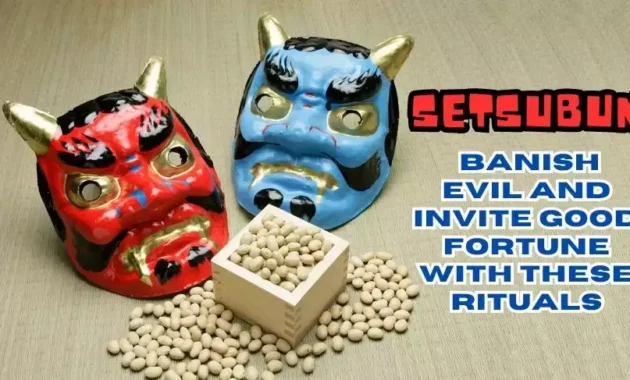Setsubun literally means “seasonal division” in Japanese and marks the beginning of spring according to the lunar calendar. It’s typically observed on February 3rd or 4th every year and is considered an important day in Japanese culture.
But why is Setsubun so important in Japanese culture? Well, it’s a time when people perform various rituals and traditions to ward off evil spirits and invite good fortune into their homes. Setsubun is seen as a way to cleanse oneself and start the new year with positive energy.
Throughout history, Setsubun has been celebrated in various ways across Japan. Families would gather to throw beans at an “oni” (demon) to drive out evil spirits and bring good luck. They also eat “ehomaki,” a type of sushi roll that’s believed to bring good fortune if eaten in silence while facing a lucky direction.
Setsubun has become an integral part of Japanese culture, with many people looking forward to the festivities each year. The traditions associated with Setsubun not only provide a way to honor the past but also bring people together in the present day.
Rituals for Banishing Evil
Alright, let’s dive into the exciting part of Setsubun – the rituals for banishing evil! One of the most well-known traditions during Setsubun is “Mame-maki,” also known as “Bean Throwing.”
So, what’s the significance of Mame-maki? Well, it’s believed that evil spirits and bad luck are attracted to beans. By throwing roasted soybeans around the house and shouting “Oni wa soto! Fuku wa uchi!” (Demons out, good luck in!), people can drive out any negative energy and invite positive energy into their homes.
Performing Mame-maki is easy and can be a fun activity for the whole family. Here are some steps to follow:
- Gather your roasted soybeans and a container to hold them.
- Stand at the entrance of your home or room facing the outside.
- Throw the beans in all directions while shouting “Oni wa soto! Fuku wa uchi!”
- Don’t forget to throw some beans behind furniture and in corners, as these are places where evil spirits might hide.
- After you finish throwing the beans, close the entrance and eat a bean for every year of your age, plus one for good luck.
Aside from Mame-maki, there are other rituals for banishing evil during Setsubun. One example is “Hassaku,” a tradition where people write their names and birth years on small wooden plates and place them outside their homes. This is believed to ward off any evil spirits that might be passing by.
Rituals for Inviting Good Fortune
Now that we’ve banished evil with Mame-maki, it’s time to invite good fortune into our lives with Setsubun’s rituals for inviting good fortune! One of the most popular traditions for this is “Ehomaki,” a sushi roll that is eaten on Setsubun day.
So, what’s the significance of Ehomaki? It’s believed that if you eat a whole sushi roll while facing the lucky direction for the year, you will have good luck and success in the year ahead. The lucky direction changes every year, based on the Chinese zodiac, and is believed to bring good energy for different aspects of life, such as health, wealth, and love.

Here’s how to prepare and eat Ehomaki:
- Choose your ingredients for the sushi roll. Traditionally, Ehomaki contains seven ingredients, such as eel, shrimp, and egg, to represent the seven gods of fortune.
- Roll the sushi in a specific way, using a full sheet of nori seaweed and leaving the ends open.
- On Setsubun day, face the lucky direction for the year and eat the whole sushi roll in silence, while making a wish for good fortune.
Aside from Ehomaki, there are other rituals for inviting good fortune during Setsubun. One example is “Fukumame,” a tradition where people eat roasted soybeans while making a wish for good luck. Another is “Kagami Biraki,” a ceremony where a special sake barrel is opened and shared with friends and family to celebrate the new year.
By performing these rituals, we can invite positive energy into our lives and set the stage for a successful and prosperous year ahead. So, why not give them a try and see what kind of good fortune comes your way?

Setsubun Celebrations Across Japan
Setsubun is a time of celebration throughout Japan, with various customs and traditions observed across the country. Let’s take a look at the different Setsubun celebrations and what makes them unique.
Setsubun is typically celebrated on February 3rd, the day before the start of spring according to the Japanese lunar calendar. It’s a time for purifying and preparing for the new year, as well as for banishing evil and inviting good fortune.
But despite these common themes, there are regional differences in Setsubun customs. For example, in western Japan, people often eat “Eho-maki” sushi rolls on Setsubun, while in eastern Japan, they throw roasted soybeans to drive away evil spirits.

Popular Setsubun festivals and events
Some popular Setsubun festivals and events include:
- The Bean-Throwing Festival at Senso-ji Temple in Tokyo – This festival attracts thousands of visitors every year, who gather to catch beans thrown by celebrities and sumo wrestlers from the temple’s balcony.
- The Setsubun Festival at Yoshida Shrine in Kyoto – This festival is known for its “Oni-oi” procession, where people dressed as demons parade through the streets to ward off evil.
- The Hama-ya (Arrow Festival) at Tado Shrine in Mie Prefecture – In this festival, archers shoot arrows with lucky amulets attached into a target, while spectators try to catch them.

Whether you’re in Tokyo, Kyoto, or Mie, there’s sure to be a Setsubun celebration near you. So why not join in the fun and experience the unique customs and traditions of this important Japanese holiday?
Setsubun Beyond Japan
Setsubun is not only celebrated in Japan, but also in other countries that have been influenced by Japanese culture. Let’s take a look at how Setsubun is celebrated in other parts of the world and compare it to similar traditions in other cultures.
Setsubun in other countries
- Hawaii – Setsubun is celebrated in Hawaii by the Japanese community, and it’s called “mamemaki.” The celebration includes traditional bean throwing, wearing demon masks, and eating ehomaki.
- Brazil – The largest Japanese community outside of Japan is in Brazil, and Setsubun is celebrated there as well. The celebration includes traditional bean throwing, wearing demon masks, and eating ehomaki.
- Indonesia – In Indonesia, Setsubun is celebrated by the Japanese community, and it’s called “mamemaki.” The celebration includes traditional bean throwing, wearing demon masks, and eating ehomaki.
Comparison with similar traditions in other cultures
- Chinese New Year – The Chinese New Year is a major holiday in China and other countries with significant Chinese populations. Just like Setsubun, the Chinese New Year is based on the lunar calendar and is celebrated with special food, decorations, and traditions to banish evil spirits and bring good luck.
- Mardi Gras – Mardi Gras, also known as Fat Tuesday, is a carnival celebration that takes place before the Christian season of Lent. Like Setsubun, it involves dressing up in costumes, throwing things (in this case, beads), and enjoying special food and festivities.
- Halloween – Halloween, celebrated on October 31st, is a holiday that originated in Ireland and is now popular in many countries. It involves dressing up in costumes, carving pumpkins, and going trick-or-treating. Like Setsubun, Halloween has roots in ancient beliefs about warding off evil spirits.
Conclusion
Setsubun is a fascinating and culturally significant tradition in Japan that has been celebrated for centuries. Its rituals and customs for banishing evil and inviting good fortune are not only interesting but also practical in our daily lives. From the bean-throwing ritual to the lucky direction sushi roll, there are many ways to celebrate Setsubun.
We encourage everyone to learn more about this unique celebration and consider participating in it. Whether you are in Japan or outside of it, there are various ways to celebrate Setsubun in your own way. So, let’s embrace this traditional festival and banish the negativity while welcoming good fortune into our lives.
Join in the fun and festivities of Setsubun, and let’s hope for a happy and prosperous year ahead!


